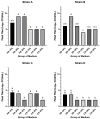Comparative Efficacy of Horse and Chicken Serum for the In Vitro Cultivation of Mycoplasma hyorhinis Clinical Isolates
- PMID: 41156667
- PMCID: PMC12567331
- DOI: 10.3390/pathogens14101056
Comparative Efficacy of Horse and Chicken Serum for the In Vitro Cultivation of Mycoplasma hyorhinis Clinical Isolates
Abstract
Mycoplasma hyorhinis is an important respiratory pathogen in swine, yet optimal culture conditions for high-yield propagation remain undefined. This study compared horse serum (HS) and chicken serum (CS) at graded concentrations (10%, 20%, 30%) for their ability to support in vitro growth of four clinical M. hyorhinis isolates (strains A, B, C, and D). Cultures were prepared in modified Friis medium, and growth performance was assessed by final titer (color changing unit, CCU/mL) and time-to-detection at 102 and 104 CCU/mL. All media supported growth, but HS consistently outperformed CS in both yield and growth kinetics. The highest titers (109 CCU/mL) and shortest detection times (3.6-6 days) were observed in 20% HS for most strains. Increasing HS concentration to 30% reduced yield for several strains, suggesting a concentration-dependent inhibitory effect. CS demonstrated limited but strain-dependent growth support, with comparable performance to HS for strain B at lower thresholds. These findings identify 20% HS as an optimal supplement for efficient M. hyorhinis cultivation, while highlighting the potential of CS as a cost-effective alternative under certain conditions, with implications for diagnostic reagent production and vaccine development.
Keywords: CCU (color changing unit); Mycoplasma hyorhinis; chicken serum; culture medium optimization; horse serum.
Conflict of interest statement
The authors declare no conflicts of interest.
Figures



References
Publication types
MeSH terms
Substances
LinkOut - more resources
Full Text Sources

